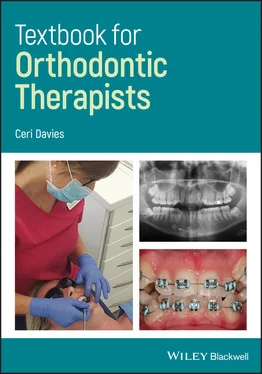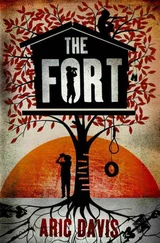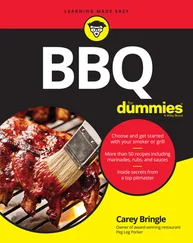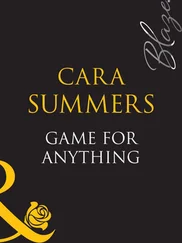1 Cover
2 Foreword Foreword It was a great honour to have been asked to prepare this foreword for the very first edition of a textbook specifically aimed at orthodontic therapists. In the past decade, orthodontics as a whole has increased exponentially and hence the demand for orthodontic therapists has proportionally increased. They have to cover a large aspect of orthodontics, similar to a three‐year postgraduate orthodontic degree, but in a third the time and almost as much information! I recommend this book to all orthodontic therapists as it is designed to impart clinical and theoretical knowledge effectively into daily clinical practice. Most importantly it has the best interests of existing and future generations of patients in mind. The goal of the author has been to put forward information in a logical sequence that will help train both experienced and training therapists alike. The layout facilitates ease of learning and clinical rationale. Well done, Ceri! Dr Shivani Patel Specialist Orthodontist BDS(Hons) MFDS RCPS MSc(Lond) IMOrth RCS FDS RCPS FICD(Hons) London, May 2019
3 Acknowledgements Acknowledgements Firstly, I would like to give a very special thanks to Dr Monica Reinach, who has given me the opportunity to progress my career into becoming an orthodontic therapist. If it was not for Monica I would not be where I am today and I cannot thank her enough for all the support she has given me over the years I worked alongside her at Pure Orthodontics. Another special thanks goes to Dr Hemant Patel and Chris Cook, my course tutors at university, in helping me to get this book published. All your help and time are very much appreciated. As well, thank you for all your help at university while I was training. Dr Shivani Patel, your help has been truly appreciated and thank you for helping me in getting this book published. Thank you to Chris Kimberly from The Specialist Orthodontic Services Lab in Manningtree, Essex, for providing me with some of the photographs used within the Removable Appliance section. My final thanks go to my work colleagues, who helped me between my clinical sessions in allowing me to use them for some of the photographs in this book. Thank you to every single one of you.
4 1 History of Orthodontics 1 History of Orthodontics The practice of orthodontics, as we know it today, is not just about correcting the position of misaligned teeth, but has a long history behind it. Teeth are important to us, and even in ancient times they were of interest. Archaeologists have found attempts to straighten teeth on human skulls, which had wire wrapped around the teeth in an attempt to realign them. It has taken the knowledge and written works of many dentists and orthodontists to reach the current state of the science.
1.1 Orthodontics before the Twenty‐First Century 1.2 Standard Edgewise Appliance 1.3 Begg Appliance 1.4 Preadjusted Edgewise Appliance 1.5 Tip Edge Appliance 1.6 Self‐ligating Appliance 1.7 Advantages and Disadvantages of all Types of Buccal Appliances 1.8 Lingual Appliances
5 2 Patient Assessment 2.1 The Three Planes of Space 2.2 Extra‐Oral Assessment 2.3 Intra‐Oral Assessment
6 3 Classification of Malocclusion 3.1 Angle’s Classification 3.2 British Standards Institute Classification 3.3 Canine Relationship 3.4 Andrew’s Six Keys
7 4 Aetiology of Malocclusion 4.1 Skeletal Factors 4.2 Soft Tissue Factors 4.3 Local Factors 4.4 Habit 4.5 Fraenal Attachments
8 5 Class I Malocclusion5.1 Definition 5.2 Prevalence 5.3 Aetiology of Class I 5.4 Treatment of Class I
9 6 Class II Div I Malocclusion6.1 Definition 6.2 Prevalence 6.3 Aetiology of Class II Div I 6.4 Treatment of a Class II Div I
10 7 Class II Div II Malocclusion7.1 Definition 7.2 Prevalence 7.3 Aetiology of Class II Div II 7.4 Treatment of Class II Div II
11 8 Class III Malocclusion8.1 Definition 8.2 Prevalence 8.3 Aetiology of Class III 8.4 Treatment
12 9 Prevalences
13 10 Hypodontia10.1 Definition 10.2 Commonly Missing Teeth 10.3 Prevalence of Hypodontia 10.4 Prevalence of Missing Teeth 10.5 Classifying Hypodontia 10.6 Classifying Missing Teeth as a Whole 10.7 Aetiology of Hypodontia 10.8 Medical Conditions Associated with Hypodontia 10.9 Factors Associated with Hypodontia 10.10 Treatment of Hypodontia in Deciduous Teeth 10.11 Treatment of Hypodontia in Permanent Teeth 10.12 Implant Space Required 10.13 Kesling Set‐up
14 11 Supernumeraries11.1 Definition 11.2 Prevalence of Supernumeraries 11.3 Aetiology of Supernumeraries 11.4 Types of Supernumeraries 11.5 Factors Caused by Supernumerary Teeth 11.6 Clinical Features of Supernumeraries 11.7 Medical Conditions Associated with Supernumeraries 11.8 Management of a Supernumerary 11.9 Types of Supernumeraries
15 12 Impacted Canines12.1 Definition 12.2 Prevalence of Maxillary Canines 12.3 Prevalence of Congenitally Missing Upper and Lower Canines 12.4 Development of the Maxillary Canine 12.5 Eruption of Upper and Lower Canines 12.6 Aetiology of Impacted Canine 12.7 Clinical Signs of an Impacted Canine 12.8 Radiographic Signs of an Impacted Canine 12.9 Parallax Technique for Radiographic Assessment of a Canine’s Position 12.10 Management of Lingual/Palatal and Buccal Canines 12.11 Dressings for Open Exposure 12.12 Risks of Impacted Canines 12.13 Position of Impacted Canines 12.14 Ankylosis
16 13 Impacted Teeth13.1 Definition 13.2 Common Impacted Teeth
17 14 Deepbites14.1 Definition 14.2 Classifying Overbites 14.3 Aetiology of a Deepbite 14.4 Treating Deepbites 14.5 Stability of a Deepbite
18 15 Openbites: Anterior and Posterior 15.1 Definition of an AOB 15.2 Prevalence of AOBs 15.3 Classification of AOBs 15.4 Aetiology of an AOB 15.5 Treatment of an AOB 15.6 Factors That May Make Stability of an AOB Poor 15.7 Definition of a POB 15.8 Facts about POBs 15.9 Aetiology of an POB 15.10 Treatment of POBs
19 16 Crossbites16.1 Definition 16.2 Types of Crossbites 16.3 Prevalence of Crossbites 16.4 Crossbites That Can Occur 16.5 Aetiology of a Crossbite 16.6 Treatment of Crossbites 16.7 Stability of a Crossbite
20 17 Centreline 17.1 Treatment Options
21 18 Overjets 18.1 Treatment Options
22 19 Bimaxillary Proclination19.1 Definition 19.2 Aetiology 19.3 Relapse 19.4 Retention
23 20 Growth Rotations
24 21 Tooth Movement21.1 Biomechanics of Tooth Movement 21.2 Types of Tooth Movement 21.3 Biology of Tooth Movement
25 22 Impressions 22.1 Materials Used for Impression Taking 22.2 Technique for Taking an Impression 22.3 Technique for Disinfecting an Impression
26 23 Study Models 23.1 Production of Study Models 23.2 What Are Study Models Used For? 23.3 Technique for Production of Study Models
27 24 Radiographs 24.1 When Are Radiographs Taken? 24.2 Types of Radiographs 24.3 Why Do We Take Radiographs? 24.4 Panoramic Radiographs 24.5 Upper Standard Occlusal (USO) 24.6 Parallax Technique 24.7 Periapical Radiographs 24.8 Reasons for Taking Radiographs 24.9 Clinical Justification for Taking Radiographs 24.10 General Principles of Radiation
28 25 Cephalometrics 25.1 The Cephalostat 25.2 Why Do We Take Cephalometrics? 25.3 When Do We Take a Cephalometric Radiograph? 25.4 Evaluating a Cephalometric Radiograph 25.5 Eastman Analysis 25.6 ANB Angle 25.7 Wits Analysis and Ballard Conversion 25.8 Vertical Skeletal Pattern 25.9 Angulation of the Incisors 25.10 Prognosis Tracing 25.11 A‐Pogonion Line (Apog) 25.12 Cephalometric Errors
29 26 Removable Appliances 26.1 Indications 26.2 Components 26.3 Active Components 26.4 Retentive Components 26.5 Anchorage 26.6 Baseplate 26.7 Advantages and Disadvantages of Removable Appliances 26.8 Stages of Removable Appliances 26.9 Instruments Used on a Removable Appliance 26.10 Fitting of a Removable Appliance
30 27 Functional Appliances 27.1 Timing of Treatment 27.2 Malocclusion Types 27.3 The End Point 27.4 Ten Key Points of Functional Appliances 27.5 Indications for Treatment 27.6 Mode of Action 27.7 Advantages and Disadvantages of Functionals 27.8 Types of Functional Appliances 27.9 Designing a Functional Appliance 27.10 Appointments
Читать дальше












